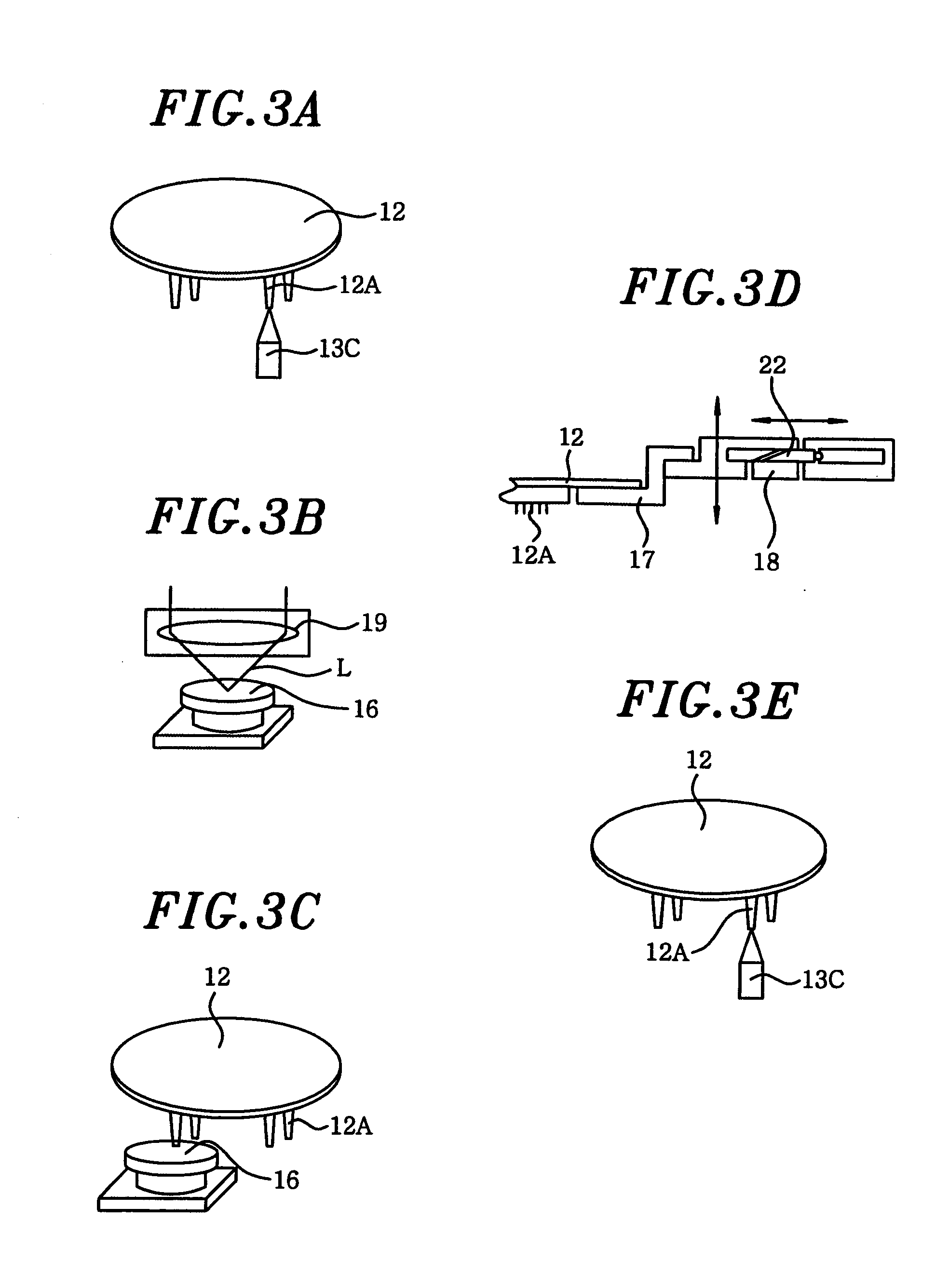Detection method of probe's tip location, storage medium storing the method, and probe device
- Summary
- Abstract
- Description
- Claims
- Application Information
AI Technical Summary
Benefits of technology
Problems solved by technology
Method used
Image
Examples
first embodiment
[0040] First of all, a probe device of the present invention will be described. As shown in FIG. 1, a probe device 10 of this embodiment includes a movable mounting table 11 for mounting thereon a wafer (not shown) serving as a test object; a probe card 12 disposed above the mounting table 11; an alignment mechanism 13 for aligning a plurality of probes 12A of the probe card 12 with the wafer on the mounting table 11; and a control unit 14 for controlling the mounting table 11, the alignment mechanism 13 and the like.
[0041] The alignment mechanism 13 is driven under the control of the control unit 14 to align the wafer on the mounting table 11 with the probes 12A of the probe card 12 and, then, the probes 12A and the wafer are made to electrically contact with each other for an electrical characteristic test of the wafer. In this embodiment, when detecting probe marks of the probes 12A, a substrate (test substrate) W having thereon a transparent film F is mounted, instead of the wa...
second embodiment
[0067] Although the first embodiment has the third step of measuring the surface height of the transparent film F by using the switch probe 19 and then detecting the positions of the probes, the second embodiment has a third step of measuring the surface height of the transparent film F by using a refractive index of the transparent film F and then detecting the positions of the probes. Since the second embodiment is same as the first embodiment except that the surface height of the transparent film F is obtained by using the refractive index of the transparent film F, the difference will be mainly explained hereinafter.
[0068] When the electrodes P of the test substrate W are detected through the transparent film F by the first CCD camera 13A, light is refracted by the transparent film F, as shown in FIGS. 2 and 6A, which hinders a detection of an actual surface height of the test substrate W. Therefore, the control unit 14 detects an apparent surface height of the test substrate W...
third embodiment
[0075] This embodiment has a feature in that a refractive index n of the transparent film F is obtained when it is unknown. In this case, since the refractive index n of the transparent film F is not known, the thickness L1 of the transparent film F and the correction value L2 of the height of the test substrate W need to be measured as can be seen from Eq. 1.
[0076] To do so, the correction value L2 on the height of the test substrate W needs to be obtained by using the first CCD camera 13A in accordance with the method shown in FIGS. 7A and 7B and, also, the thickness L1 of the transparent film F needs to be obtained by using the switch probe 19 in accordance with the method described with reference to FIGS. 8A and 8B. Since the numerical aperture of the first CCD camera 13A is known, tan ø can be obtained by substituting the known values in Eq. 1. The refractive index n (=sin ø / sin θ) of the transparent film F can be calculated based on tan θ and the equation, i.e., n=sin ø / sin θ...
PUM
 Login to View More
Login to View More Abstract
Description
Claims
Application Information
 Login to View More
Login to View More - R&D
- Intellectual Property
- Life Sciences
- Materials
- Tech Scout
- Unparalleled Data Quality
- Higher Quality Content
- 60% Fewer Hallucinations
Browse by: Latest US Patents, China's latest patents, Technical Efficacy Thesaurus, Application Domain, Technology Topic, Popular Technical Reports.
© 2025 PatSnap. All rights reserved.Legal|Privacy policy|Modern Slavery Act Transparency Statement|Sitemap|About US| Contact US: help@patsnap.com



